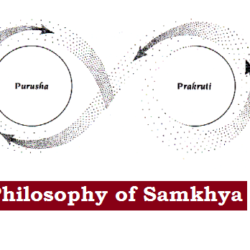
The Samkhya Philosophy is regarded as dualistic realism; dualistic because it holds the doctrine of two ultimate realities: Prakriti (non-self) and Purusa (self). It is realism because it views that both matter (non-self) and spirit (self) are equally real; also both are radically different form each other, as like, subject and object.
The word Samkhya is derived from the word ‘Samkhya’ which means number as well as right knowledge. Right knowledge is about understanding the reality. Samkhya Philosophy argues for the cause of evolution of the world, the role of Purusa and Prakriti for the creation of the universe, valid sources of knowledge, and on the existence of God.
The founder of Samkhya Philosophy is Kapila who has written the script Samkhya Sutra which is widely known as Samkhya Philosophy.
Satkaryavada (Theory of Causation)
According to Samkhya Philosophy, Prakriti is the ultimate (first) cause of all objects, including our mind, body and sense organs. It is observed that every effect must have a cause. Cause and effect are two inseparable components stand for all sorts of creation in the cosmos. Hence, all objects of the world are bounded in the chain of cause-effect relation, named as ‘Satkaryavada’.
It explains the effect exists in its material cause prior to its production. For example, curd was existing in the milk before comes into existence. Hence, the effect is not a real beginning or a new creation. It is also named as Parinamavada.
Nature of Purusha
Purusa is the transcendental self or pure consciousness. It is absolute, independent, free, imperceptible, above any experience by mind or senses and beyond any words or explanations. It has been described as, devoid of three Gunas and is eternal- not subject to change (inactive). It is the basis of all knowledge and is the supreme knower.
According to Samkhya Philosophy, the Purusa is of the nature of pure consciousness and hence beyond the limits of Prakriti.
Samkhya has given the following arguments for establishing the existence of Purusa:
- As Prakriti is unconscious, it can’t enjoy its creation, it evolves itself (Bhogya) in order to serve the Purusa’s end (Bhokta).
- The Purusa is the witness of three Gunaswhich compose the all substances of the universe and itself is beyond from these Gunas.
- Purusa is the sole authority of all experiential knowledge, beyond our experience and analysis. There can be no experience without it.
Samkhya Philosophy believes there are pluralities of Purusa and all these Purusas are identical in their essences and they are embedded with consciousness. Hence, consciousness is found in all the selves. This view is similar to Jainism and Mimansa because they believe in the plurality of selves.
Nature of Prakriti
Prakriti is the first and ultimate cause of the universe- of everything except the Purusa. It is also eternal, but unconscious, and active.
All effects of the universe are based upon it. Being the first element of the universe, Prakriti itself is uncaused, eternal, and all pervading; hence called Pradhana. It can’t be perceived but can be inferred from its effect; thus known as Aanuma. In the form of conscious elements, it is called Jada, and in the form of the unmanifested objects, it is called Avayakta.
Objects are the effects of Prakriti. These are dependent, relative, many and non-eternal because they are created and destroyed.
Samkhya has given the following arguments for establishing the existence of Prakriti:
- The objects constitute the universe therefore the existence of all the objects must have a cause. This is so because they themselves can’t be the cause of their creation which is Prakriti.
- Some common qualities– pleasure, pain and indifference are found among all the objects. Therefore, there should be a common cause which possesses these three qualities which is Prakriti.
- All effects arise out of causes in which they were present in an unmanifest form (Satkaryavada). These causes are nothing but due to Prakriti.
Three Gunas of Prakriti:
The Samkhya Philosophy advocates three Gunas of Prakriti: Sattva, Rajas and Tamas. The word ‘Guna’ is understood here as quality or attribute.
- Sattva (light or pleasure): The tendency towards conscious manifestation in the senses, the mind and the intellect. For example, blazing up a fire, upward curse of vapour etc. It is believed to be white in color.
- Rajas (virility or activity): It is active because of its mobility and stimulation. It is also the nature of pain. For example, on account of rajas, fire spread; wind blows; the mind becomes restless, etc. It is believed to be red in color.
- Tamas (darkness or negativity): It produces ignorance and darkness and leads to confusion and bewilderment. It is believed to be black in color.
Prakriti is a state of equilibrium of these three Gunas. Sattva, Rajas and Tamas contradict as well as cooperate among each other to produce an object. None of them exist alone.
Swarupa Parinama and Virupa Parinama:
When these Gunas are held in a state of equilibrium (Prakriti State), evolution of worldly objects does not take place at this state. These Gunas are said to be ever – changing or transforming (Parinama) and cannot remain static even for a moment.
Change is said to be of two kinds:
- Swarupa (Homogenous): In this stage, the Gunas can neither create nor produce anything. That is, Sattva changes into Sattva, Rajas changes into Rajas and Tamas changes into Tamas.
- Virupa (Heterogeneous): In this stage, the Gunas are in a state of constant flux and each tries to dominate the others. It is this flux of Gunas that results in the formation of various objects. So, it is the starting point of the world’s evolution.
Vikasavada: Theory of Evolution
The world and worldly objects are created because of the contact between Prakriti and Purusa. The Prakriti alone can’t create the world because it is material. In the same manner the Purusa can’t create the world independently because he is inactive. Hence, the contact between Prakriti and Purusa is necessary for the evolution to start though they are possessing different and opposite natures.
There is no real contact took place between them, but their mere closeness with each other disturbs the stability of the Gunas of Prakriti. Evolution begins as a result of these disturbances (transformations) and one product produces another product in the next order.
Order of creation (evolution):
- Mahat (Intellect or Buddhi): An important function of Buddhi is to take decision which is a part of memory act. This helps to distinguish between the known and the knower. Sattva is predominately found as an attribute of Buddhi. Mahat produces Ahamkara.
- Ahamkara (Ego): It is a practical element of Buddhi and found in all individuals. Because of ego the Purusa looks upon himself as an active agent, desire and strive for ends, and possesses characteristics. All these three Gunas of Prakriti operates in Ahamakara state. Ahamkara in its Sattva aspect evolves into Manas, Jnanendriyas and Karmendriyas whereas in its Tamas aspect evolves into Tanmatras.
- Manas (Mind): It helps to analyze and synthesize the sense-data into determinate perceptions. It is constituted with parts and thus can come into contact with the different sense organs simultaneously.
- Jnanendriyas (Sense organs): The five sense organs produce knowledge of touch, colour, smell, heard, and taste. The senses are not perceptible but can infer. For example, the sense is not the ears but their power of hearing.
- Karmendriyas (Action organs): Five action organs- mouth, ears, feet, anus and the sex organ perform the functions respectively as speech, hearing, movement, excretion, and reproduction.
- Tanmatras (Subtle essence): There are five subtle essences- sight, smell, taste, touch and sound. All are very subtle because they are the elements of the objects. Hence, they can’t be perceived but inferred. The Samkhya School viewed that the five elements; earth, water, air, fire, and ether have their origin in them.
- Mahabhutas (Five elements): Five subtle essences evolve into the five gross elements of earth, water, light, air and ether by a predomination of Tamas.

Thus the process of evolution of the universe includes the operation of 24 principles, of which Prakriti is the first, the 5 gross elements are the last and 10 organs and 5 Tanmatras are the intermediate ones. The evolution of Prakritiinto the world of objects makes it possible for the selves to enjoy or suffer the consequences of their good or bad actions. The ultimate end of evolution of Prakriti, therefore, is the freedom (Mukti) of Purusa.

 Home
Home Syllabus
Syllabus Contact Us
Contact Us




